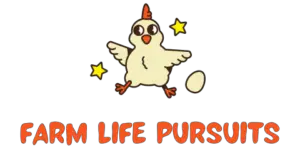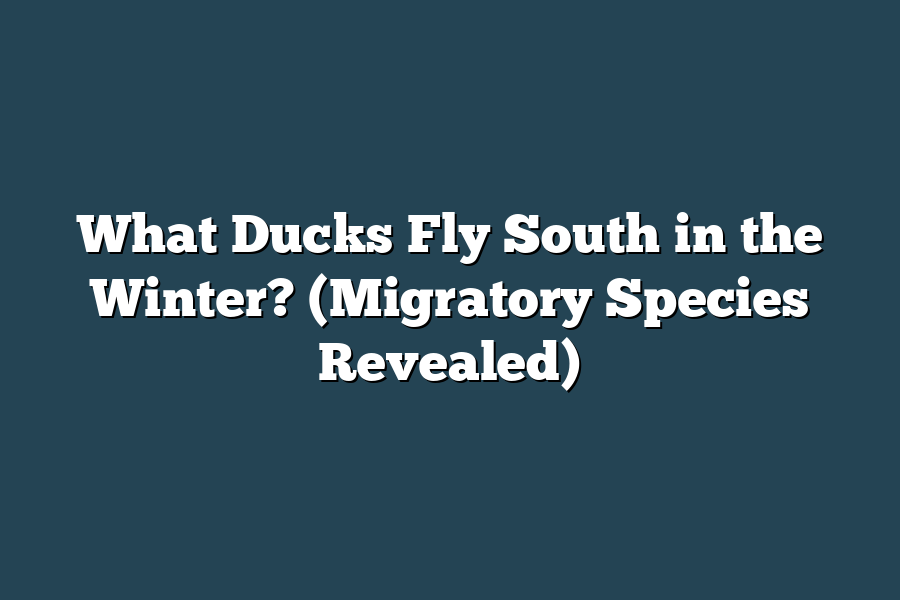Migratory ducks, such as mallards, teal, and pintails, fly south in the winter to escape colder temperatures and find better food sources. These ducks travel to warmer regions where they can find open water and abundant food to survive the winter months. Once the weather begins to warm up again in the spring, they will migrate back north to their breeding grounds to nest and raise their young.
Have you ever marveled at ducks flying south in winter?
Join me as we explore the world of migratory ducks – from their reasons for the journey to their challenges, and the conservation efforts in place.
🦆✈️ #MigratoryMagic
Table of Contents
The Significance of Migratory Behavior for Duck Species
Have you ever wondered why some ducks fly south in the winter while others stay put?
Well, the answer lies in the migratory behavior of these fascinating bird species.
Let’s dive into the significance of this behavior and understand why it’s so crucial for duck populations.
Why Do Ducks Migrate?
Migratory behavior is a natural phenomenon observed in many bird species, including ducks.
The primary reason ducks migrate is to find suitable habitats that can provide them with food, shelter, and breeding grounds.
As winter approaches and temperatures drop, ducks from colder regions instinctively know it’s time to head south in search of warmer climates and abundant food sources.
Survival Instincts at Play
For ducks, migration is not just a seasonal journey—it’s a matter of survival.
By flying to warmer regions during the winter months, ducks can escape harsh weather conditions that make it challenging to find food and stay warm.
Additionally, migrating allows ducks to avoid competition for resources with resident bird populations, ensuring their survival during the colder months.
Genetic Programming in Action
The migratory behavior of ducks is deeply ingrained in their genetic makeup.
Studies have shown that certain duck species possess a genetic predisposition to migrate, passed down from generation to generation.
This genetic programming guides ducks on their epic journeys across vast distances, often spanning thousands of miles.
Environmental Factors Influence Migration Patterns
While genetic factors play a significant role in driving duck migration, environmental cues also play a crucial role in shaping migration patterns.
Ducks are highly sensitive to changes in daylight, temperature, and food availability, which act as triggers for their migratory behavior.
These environmental factors help ducks determine the optimal time to begin their journey southward.
The Impact of Climate Change
In recent years, climate change has altered traditional migration patterns for many bird species, including ducks.
Warmer winters and shifting food sources have led to changes in the timing and routes of duck migration.
As a result, researchers are closely monitoring these changes to understand how climate change is impacting duck populations and their long-term survival.
Conservation Efforts to Protect Migratory Birds
Given the importance of migratory behavior for duck species, conservation efforts are crucial to protect these bird populations.
Organizations like the National Audubon Society and Ducks Unlimited work tirelessly to preserve critical habitats along migratory routes, ensuring that ducks have safe stopover points and breeding grounds during their journeys.
the migratory behavior of ducks is a remarkable adaptation that allows these birds to survive and thrive in diverse environments.
By understanding the significance of migration for duck species, we can appreciate the remarkable journey these birds undertake each year and work together to ensure their continued well-being.
Popular Species of Migratory Ducks and Their Winter Travel Destinations
As winter approaches, many species of ducks undergo a remarkable journey, flying south to warmer climates in search of food and more hospitable conditions.
Let’s take a closer look at some of the popular migratory ducks and their winter travel destinations.
Mallard Ducks
One of the most recognizable duck species, Mallards can be found across North America, Europe, and Asia.
During the winter months, Mallards from North America migrate south to regions such as Mexico and the southern United States.
These ducks are known for their adaptability, which allows them to thrive in a variety of habitats.
Northern Pintail Ducks
Northern Pintails are elegant birds with long, pointed tails.
They breed in northern regions of North America and Eurasia and migrate south for the winter.
Many Northern Pintails travel to Central and South America, as well as parts of Africa and Asia.
These ducks are known for their spectacular aerial displays during migration.
Wood Ducks
Known for their colorful plumage, Wood Ducks are a sight to behold.
These ducks are found in wooded swamps and freshwater marshes across North America.
During the winter, some Wood Ducks migrate south to warmer areas such as Florida and the Gulf Coast.
Their striking appearance and unique habitat make them a favorite among birdwatchers.
Blue-winged Teal Ducks
Blue-winged Teal Ducks are small, fast-flying birds with distinctive blue and white markings on their wings.
They breed in northern regions of North America and travel south for the winter.
Many Blue-winged Teal Ducks head to Central and South America, where they can find abundant food sources and milder temperatures.
migratory ducks undertake incredible journeys to escape the harsh winter conditions and find suitable habitats for survival.
By exploring the popular species of migratory ducks and their winter travel destinations, we gain a deeper appreciation for the resilience and adaptability of these remarkable birds.
Next time you see a flock of ducks overhead, remember the amazing distances they travel each year in search of a better life.
Challenges Faced by Migratory Ducks During Winter Migration
As migratory ducks embark on their journey south for the winter, they encounter a multitude of challenges that test their resilience and survival instincts.
Let’s dive into the various obstacles these magnificent birds face along their migration route.
1. Adverse Weather Conditions
Winter migration exposes ducks to harsh weather conditions, including freezing temperatures, strong winds, and heavy snowfall.
These extreme elements can take a toll on their energy reserves, making it difficult for them to find suitable resting and feeding grounds.
2. Predation Risk
During migration, ducks are more vulnerable to predators as they navigate unfamiliar territories.
Predatory birds, mammals, and even humans pose a threat to these migrating flocks, leading to increased stress and vigilance among the ducks.
3. Habitat Loss and Fragmentation
The loss of wetland habitats due to human development and climate change presents a significant challenge for migratory ducks.
As their traditional stopover sites disappear or become fragmented, ducks must adapt to new environments, often with limited resources and shelter.
4. Competition for Resources
As migratory ducks join resident bird populations in wintering grounds, competition for food and shelter intensifies.
Limited resources can force ducks to travel longer distances in search of sustenance, putting additional strain on their already arduous journey.
5. Physical Fatigue
Covering thousands of miles during migration demands tremendous physical endurance from ducks.
The constant need to fly, forage, and evade predators can lead to fatigue and muscle strain, impacting their overall health and survival prospects.
6. Navigation Challenges
Navigating across vast distances to reach their wintering grounds is a complex task for migratory ducks.
Disorientation, inclement weather, and changing landscapes can disorient them, leading to delays in their migration schedule and increased exposure to risks.
the winter migration of ducks presents a formidable set of challenges that test their adaptability and perseverance.
By understanding and addressing these obstacles, we can appreciate the remarkable journey undertaken by these resilient birds each year.
Conservation Efforts to Protect Migratory Duck Populations
Have you ever wondered how conservation efforts play a crucial role in safeguarding the well-being of migratory duck populations during their journey south in the winter?
Let’s dive into the remarkable initiatives and strategies put in place to protect these incredible birds.
Importance of Conservation:
Conservation efforts are vital to ensuring the survival of migratory ducks as they travel thousands of miles to their wintering grounds.
By preserving their habitats and reducing threats, conservationists contribute to the overall health and sustainability of these populations.
Habitat Protection:
One key aspect of conservation efforts is the protection of crucial habitats for migratory ducks.
Wetlands, lakes, and marshes serve as essential stopover points where ducks can rest and refuel during their long journey.
By establishing protected areas and enforcing regulations, conservationists create safe havens for ducks to thrive.
Regulation of Hunting Practices:
In addition to habitat protection, regulating hunting practices is another crucial step in safeguarding migratory duck populations.
Sustainable hunting practices, including hunting season limits and regulations on hunting methods, help prevent overexploitation of duck populations and ensure their numbers remain stable.
Partnership with Organizations:
Collaboration with organizations such as Ducks Unlimited and the National Audubon Society plays a significant role in conservation efforts for migratory ducks.
These organizations work tirelessly to raise awareness, secure funding, and implement conservation projects that benefit duck populations across their migration routes.
Success Stories:
One inspiring success story in the realm of duck conservation is the increase in waterfowl populations due to dedicated conservation efforts.
For example, the North American Waterfowl Management Plan has led to the restoration of millions of acres of wetlands, contributing to the resurgence of duck populations and enhancing their habitats.
:
conservation efforts are instrumental in protecting migratory duck populations during their journey south in the winter.
By focusing on habitat protection, regulating hunting practices, and fostering partnerships with organizations, conservationists play a crucial role in ensuring the well-being of these remarkable birds.
Through collaborative efforts and dedication, we can continue to preserve and celebrate the beauty of migratory ducks for generations to come.
Final Thoughts
The winter migration of ducks is not just a natural spectacle but a critical aspect of their survival and reproductive success.
Understanding the significance of migratory behavior for duck species sheds light on the resilience and adaptability of these magnificent creatures.
As we marvel at the journey of species like the Mallard, Northern Pintail, and Green-winged Teal to warmer climates, let’s also consider the challenges they face en route and the importance of conservation efforts in protecting their populations.
Next time you spot a V-formation of ducks flying south in the winter, take a moment to appreciate the incredible journey they undertake.
You can even take it a step further by supporting local conservation initiatives or spreading awareness about the importance of preserving the habitats these migratory ducks depend on.
Together, we can play a role in safeguarding these remarkable species for generations to come.
So, let’s ensure that the skies continue to be filled with the awe-inspiring sight of migratory ducks embarking on their seasonal adventures.

